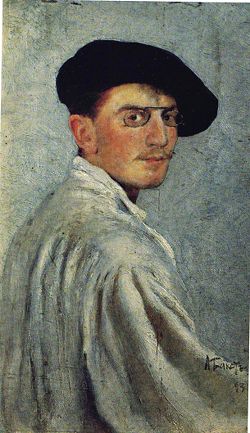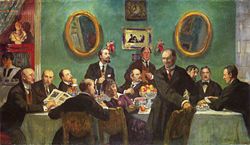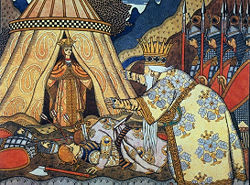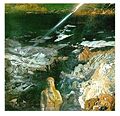Difference between revisions of "Leon Bakst" - New World Encyclopedia
(fix) |
|||
| Line 10: | Line 10: | ||
==Mir Iskusstva== | ==Mir Iskusstva== | ||
| − | ''World of Art'') was a [[Russia]]n [[magazine]] and the artistic movement it inspired and embodied, which was a major influence on the Russians who helped revolutionize European art during the first decade of the 20th century. | + | ''World of Art'') was a [[Russia]]n [[magazine]] and the artistic movement it inspired and embodied, which was a major influence on the Russians who helped revolutionize European art during the first decade of the 20th century. From 1909, many of the ''miriskusniki'' (i.e., members of the movement) also contributed to the [[Ballets Russes]] company operating in [[Paris]]. Paradoxically, few Western Europeans actually saw [http://nla.gov.au/nla.cat-vn3122830 issues of the magazine itself]. |
== History == | == History == | ||
| − | The artistic group was founded in 1898 by a group of students that included [[Alexandre Benois]], [[Konstantin Somov]], [[Dmitry Filosofov]], [[Léon Bakst]], and [[Eugene Lansere]]. | + | The artistic group was founded in 1898 by a group of students that included [[Alexandre Benois]], [[Konstantin Somov]], [[Dmitry Filosofov]], [[Léon Bakst]], and [[Eugene Lansere]]. The starting moments for the new artistic group was organization of the ''Exhibition of Russian and Finnish Artists'' in the [[Stieglitz Museum of Applied Arts]] in [[Saint-Petersburg]]. |
| − | The magazine was cofounded in 1899 in [[Saint Petersburg|St. Petersburg]] by Alexandre Benois, Léon Bakst, and [[Sergei Diaghilev]] (the Chief Editor). | + | The magazine was cofounded in 1899 in [[Saint Petersburg|St. Petersburg]] by Alexandre Benois, Léon Bakst, and [[Sergei Diaghilev]] (the Chief Editor). They aimed at assailing low artistic standards of the obsolescent [[Peredvizhniki]] school and promoting artistic individualism and other principles of [[Art Nouveau]]. The theoretical declarations of the art movements were stated in the Diaghilev's articles "Difficult Questions," "Our Imaginary Degradation," "Permanent Struggle," "In Search of Beauty," and "The Fundamentals of Artistic Appreciation" published in the N1/2 and N3/4 of the new journal. [[Image:Kustodiyev world of the art.JPG|thumb|250px|left|"Members of the ''World of Art'' Movement," by [[Boris Kustodiev]] (1916-1920).]] |
| − | Apart from three founding fathers, active members of the ''World of Art'' included [[Mstislav Dobuzhinsky]], [[Eugene Lansere]], and [[Konstantin Somov]]. | + | Apart from three founding fathers, active members of the ''World of Art'' included [[Mstislav Dobuzhinsky]], [[Eugene Lansere]], and [[Konstantin Somov]]. Exhibitions organized by the ''World of Art'' attracted many illustrious painters from Russia and abroad, notably [[Mikhail Vrubel]], [[Mikhail Nesterov]], and [[Isaac Levitan]]. |
| − | In its "classical period" (1898-1904) the art group organized six exhibitions: 1899 (International), 1900, 1901 (At the [[Imperial Academy of Arts]], Saint Petersburg), 1902 ([[Moscow]] and Saint Petersburg), 1903, 1906 (Saint Petersburg). | + | In its "classical period" (1898-1904) the art group organized six exhibitions: 1899 (International), 1900, 1901 (At the [[Imperial Academy of Arts]], Saint Petersburg), 1902 ([[Moscow]] and Saint Petersburg), 1903, 1906 (Saint Petersburg). The sixth exhibition was seen as a Dyagilev's attempt to prevent the separation from the Moscow members of the group who organized a separate "Exhibition of 36 artists" (1901) and later "The Union of Russian Artists" group (from 1903). |
| − | In 1904-1910, ''Mir Iskusstva'' as a separate artistic group did not exist. Its place was inherited by the '''Union of Russian Artists''' which continued officially until 1910 and unofficially until 1924. | + | In 1904-1910, ''Mir Iskusstva'' as a separate artistic group did not exist. Its place was inherited by the '''Union of Russian Artists''' which continued officially until 1910 and unofficially until 1924. The Union included painters ([[Valentin Serov]], [[Konstantin Korovin]], [[Boris Kustodiev]], [[Zinaida Serebriakova]]), illustrators ([[Ivan Bilibin]], [[Konstantin Somov]]), restorators ([[Igor Grabar]]), and scenic designers ([[Nicholas Roerich]], [[Serge Sudeikin]]). |
| − | In 1910 Benois published a critical article in the magazine "[[Rech']]" about the Union of Russian Artists. ''Mir Iskusstva'' was recreated. The new chairman became [[Nicholas Roerich]]. The group took new members including [[Nathan Altman]], [[Vladimir Tatlin]], and [[Martiros Saryan]]. Some said that the inclusion of the [[Russian avant-garde]] painters demonstrated that the group had become an exhibition organization rather than an art movement. | + | In 1910 Benois published a critical article in the magazine "[[Rech']]" about the Union of Russian Artists. ''Mir Iskusstva'' was recreated. The new chairman became [[Nicholas Roerich]]. The group took new members including [[Nathan Altman]], [[Vladimir Tatlin]], and [[Martiros Saryan]]. Some said that the inclusion of the [[Russian avant-garde]] painters demonstrated that the group had become an exhibition organization rather than an art movement. In 1917 the chairman of the group became [[Ivan Bilibin]]. The same year most members of the [[Jack of Diamonds (artists)|Jack of Diamonds]] entered the group. |
| − | The group organized numerous exhibitions: 1911, 1912, 1913, 1915, 1916, 1917, 1918, 1921, 1922 Saint-Petersburg, Moscow). | + | The group organized numerous exhibitions: 1911, 1912, 1913, 1915, 1916, 1917, 1918, 1921, 1922 Saint-Petersburg, Moscow). The last exhibition of ''Mir Iskusstva'' was organized in [[Paris]] in 1927. Some members of the group entered the ''[[Zhar-Tsvet]]'' (Moscow, organized in 1924) and ''[[Four Arts]]'' (Moscow-Leningrad, organized in 1925) artistic movements. |
== Art == | == Art == | ||
| Line 34: | Line 34: | ||
Like the Romantics before them, the ''miriskusniki'' promoted understanding and conservation of the art of previous epochs, particularly traditional [[folk art]] and the 18th-century [[rococo]]. [[Antoine Watteau]] was probably the single artist whom they admired the most. | Like the Romantics before them, the ''miriskusniki'' promoted understanding and conservation of the art of previous epochs, particularly traditional [[folk art]] and the 18th-century [[rococo]]. [[Antoine Watteau]] was probably the single artist whom they admired the most. | ||
| − | Such Revivalist projects were treated by the ''miriskusniki'' [[humor]]ously, in a spirit of self-[[parody]]. | + | Such Revivalist projects were treated by the ''miriskusniki'' [[humor]]ously, in a spirit of self-[[parody]]. They were fascinated with [[mask]]s and [[marionette]]s, with [[carnaval]] and [[puppet theater]], with [[dream]]s and [[fairy-tale]]s. Everything [[grotesque]] and playful appealed to them more than the serious and emotional. Their favorite city was [[Venice]], so much so that [[Diaghilev]] and [[Igor Stravinsky|Stravinsky]] selected it as the place of their burial. |
As for media, the ''miriskusniki'' preferred the light, airy effects of [[watercolor painting|watercolor]] and [[gouache]] to full-scale oil paintings. Seeking to bring art into every house, they often designed [[interior]]s and [[book]]s. Bakst and Benois revolutionized [[theatrical design]] with their ground-breaking decor for ''[[Cléopâtre]]'' (1909), ''Carnaval'' (1910), ''[[Petrushka]]'' (1911), and ''[[Afternoon of a Faun (ballet)|L'après-midi d'un faune]]'' (1912). | As for media, the ''miriskusniki'' preferred the light, airy effects of [[watercolor painting|watercolor]] and [[gouache]] to full-scale oil paintings. Seeking to bring art into every house, they often designed [[interior]]s and [[book]]s. Bakst and Benois revolutionized [[theatrical design]] with their ground-breaking decor for ''[[Cléopâtre]]'' (1909), ''Carnaval'' (1910), ''[[Petrushka]]'' (1911), and ''[[Afternoon of a Faun (ballet)|L'après-midi d'un faune]]'' (1912). | ||
Revision as of 00:56, 13 August 2008
Léon Samoilovitch Bakst (May 10, 1866 - December 28,1924) was a Russian painter and scene- and costume designer who revolutionized the arts he worked in. Born as Lev (Leib) Rosenberg, he was also known as Leon (Lev) Nikolayevich Bakst (Леон (Лев) Николаевич Бакст). "Bakst" is his pseudonym derived from his grandmother's family name, Bakster (Baxter).
Early life
Leon was born in Grodno (currently Belarus) in a middle-class Jewish family. After graduating from gymnasium, he studied in St. Petersburg Academy of Arts as a noncredit student, working part-time as a book illustrator.
On his first exhibition (1889) he took the name of Bakst based on his maternal grandmother's family name Baxter. At the beginning of the 1890s he exhibited his works with Society of watercolorists. During 1893 - 1897 he lived in Paris, where he studied at the Académie Julian while still visiting Saint Petersburg often. After the mid-1890s he became a member of the circle of writers and artists formed by Sergei Diaghilev and Alexandre Benois, which later became the Mir Iskusstva art movement.
In 1899, he co-founded with Sergei Diaghilev the influential periodical World of Art. His graphics for the World of Art magazine brought him international fame.
Mir Iskusstva
World of Art) was a Russian magazine and the artistic movement it inspired and embodied, which was a major influence on the Russians who helped revolutionize European art during the first decade of the 20th century. From 1909, many of the miriskusniki (i.e., members of the movement) also contributed to the Ballets Russes company operating in Paris. Paradoxically, few Western Europeans actually saw issues of the magazine itself.
History
The artistic group was founded in 1898 by a group of students that included Alexandre Benois, Konstantin Somov, Dmitry Filosofov, Léon Bakst, and Eugene Lansere. The starting moments for the new artistic group was organization of the Exhibition of Russian and Finnish Artists in the Stieglitz Museum of Applied Arts in Saint-Petersburg.
The magazine was cofounded in 1899 in St. Petersburg by Alexandre Benois, Léon Bakst, and Sergei Diaghilev (the Chief Editor). They aimed at assailing low artistic standards of the obsolescent Peredvizhniki school and promoting artistic individualism and other principles of Art Nouveau. The theoretical declarations of the art movements were stated in the Diaghilev's articles "Difficult Questions," "Our Imaginary Degradation," "Permanent Struggle," "In Search of Beauty," and "The Fundamentals of Artistic Appreciation" published in the N1/2 and N3/4 of the new journal.
Apart from three founding fathers, active members of the World of Art included Mstislav Dobuzhinsky, Eugene Lansere, and Konstantin Somov. Exhibitions organized by the World of Art attracted many illustrious painters from Russia and abroad, notably Mikhail Vrubel, Mikhail Nesterov, and Isaac Levitan.
In its "classical period" (1898-1904) the art group organized six exhibitions: 1899 (International), 1900, 1901 (At the Imperial Academy of Arts, Saint Petersburg), 1902 (Moscow and Saint Petersburg), 1903, 1906 (Saint Petersburg). The sixth exhibition was seen as a Dyagilev's attempt to prevent the separation from the Moscow members of the group who organized a separate "Exhibition of 36 artists" (1901) and later "The Union of Russian Artists" group (from 1903).
In 1904-1910, Mir Iskusstva as a separate artistic group did not exist. Its place was inherited by the Union of Russian Artists which continued officially until 1910 and unofficially until 1924. The Union included painters (Valentin Serov, Konstantin Korovin, Boris Kustodiev, Zinaida Serebriakova), illustrators (Ivan Bilibin, Konstantin Somov), restorators (Igor Grabar), and scenic designers (Nicholas Roerich, Serge Sudeikin).
In 1910 Benois published a critical article in the magazine "Rech'" about the Union of Russian Artists. Mir Iskusstva was recreated. The new chairman became Nicholas Roerich. The group took new members including Nathan Altman, Vladimir Tatlin, and Martiros Saryan. Some said that the inclusion of the Russian avant-garde painters demonstrated that the group had become an exhibition organization rather than an art movement. In 1917 the chairman of the group became Ivan Bilibin. The same year most members of the Jack of Diamonds entered the group.
The group organized numerous exhibitions: 1911, 1912, 1913, 1915, 1916, 1917, 1918, 1921, 1922 Saint-Petersburg, Moscow). The last exhibition of Mir Iskusstva was organized in Paris in 1927. Some members of the group entered the Zhar-Tsvet (Moscow, organized in 1924) and Four Arts (Moscow-Leningrad, organized in 1925) artistic movements.
Art
Like the English pre-Raphaelites before them, Benois and his friends were disgusted with anti-aesthetic nature of modern industrial society and sought to consolidate all Neo-Romantic Russian artists under the banner of fighting Positivism in art.
Like the Romantics before them, the miriskusniki promoted understanding and conservation of the art of previous epochs, particularly traditional folk art and the 18th-century rococo. Antoine Watteau was probably the single artist whom they admired the most.
Such Revivalist projects were treated by the miriskusniki humorously, in a spirit of self-parody. They were fascinated with masks and marionettes, with carnaval and puppet theater, with dreams and fairy-tales. Everything grotesque and playful appealed to them more than the serious and emotional. Their favorite city was Venice, so much so that Diaghilev and Stravinsky selected it as the place of their burial.
As for media, the miriskusniki preferred the light, airy effects of watercolor and gouache to full-scale oil paintings. Seeking to bring art into every house, they often designed interiors and books. Bakst and Benois revolutionized theatrical design with their ground-breaking decor for Cléopâtre (1909), Carnaval (1910), Petrushka (1911), and L'après-midi d'un faune (1912).
Rise to fame
He continued easel painting as well producing portraits of Filipp Malyavin (1899), Vasily Rozanov (1901), Andrei Bely (1905), Zinaida Gippius (1906). He also worked as an art teacher for children of Grand Duke Vladimir Alexandrovich. In 1902 he took a commission from Tsar Nicholas II to paint Meeting of Russian sailors in Paris.
In 1898 he showed his works in the Diaghilev-organized First exhibition of Russian and Finnish Artists; in World of Art exhibitions, as well as the Munich Secession, exhibitions of the Union of Russian Artists, etc.
During the Russian Revolution of 1905 Bakst worked for magazines Zhupel, Adskaja Pochta, Satyricon, then for art magazine Apollon.
Stage design
Beginning in 1909 Bakst worked mostly as a stage-designer, designing sets for Greek tragedies, and in 1908 made a name as a scene-painter for Diaghilev with the Ballets Russes (Cleopatra (1909), Scheherazade (1910), Carnaval (1910), Narcisse (1911), Le Spectre de la rose (1911), Daphnis et Chloé (1912)). All that time he lived in Europe because as a Jew he did not have the right to live permanently outside the Pale of Settlement.
During his visits to Saint Petersburg he taught in Zvantseva's school. One of his students was Marc Chagall (1908-1910). In 1910 they broke. Bakst advised Chagall not to go to Paris as, according to Bakst, it would be harmful for Chagall's art and financially would probably cause him to die of starvation. Chagall moved there anyway, did not die and actually found his style.
In 1914 Bakst was elected a member of the Imperial Academy of Arts.
In 1922 he broke his relationship with Diaghilev and the Ballets Russes. He died in 1924 in Paris from lung problems.
Selected works
Andrei Bely, 1905
Zinaida Gippius, 1906
Nijinsky in the ballet L'après-midi d'un faune 1912
External links
- Ëåâ Áàêñò-áèîãðàôèÿ at www.silverage.ru (in Russian)
- BAKST at www.rollins.edu
- Leon Bakst (1866 - 1924) Artwork Images, Exhibitions, Reviews at wwar.com
- Works by Leon Bakst at the Russian Art Gallery
- Léon Bakst - A Virtual Gallery
Sources
- Marc Chagall, My Life, St.-Petersburg, Azbuka, 2000, ISBN 5-267-00200-3
Credits
New World Encyclopedia writers and editors rewrote and completed the Wikipedia article in accordance with New World Encyclopedia standards. This article abides by terms of the Creative Commons CC-by-sa 3.0 License (CC-by-sa), which may be used and disseminated with proper attribution. Credit is due under the terms of this license that can reference both the New World Encyclopedia contributors and the selfless volunteer contributors of the Wikimedia Foundation. To cite this article click here for a list of acceptable citing formats.The history of earlier contributions by wikipedians is accessible to researchers here:
The history of this article since it was imported to New World Encyclopedia:
Note: Some restrictions may apply to use of individual images which are separately licensed.












